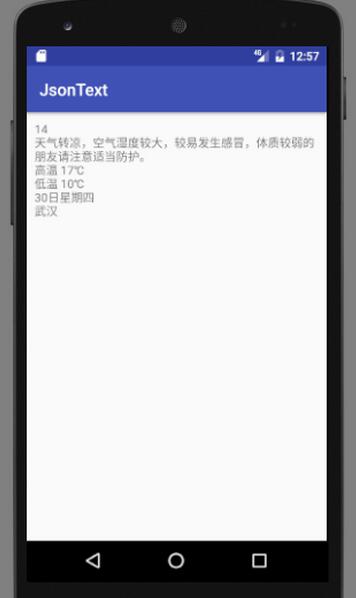您好,登錄后才能下訂單哦!
您好,登錄后才能下訂單哦!
不懂android JSON解析數據實現天氣預報的方法?其實想解決這個問題也不難,下面讓小編帶著大家一起學習怎么去解決,希望大家閱讀完這篇文章后大所收獲。
JSON數據如下:
{
"desc": "OK",
"status": 1000,
"data": {
"wendu": "14",
"ganmao": "天氣轉涼,空氣濕度較大,較易發生感冒,體質較弱的朋友請注意適當防護。",
"forecast": [
{
"fengxiang": "無持續風向",
"fengli": "微風級",
"high": "高溫 17℃",
"type": "小雨",
"low": "低溫 10℃",
"date": "30日星期四"
},
{
"fengxiang": "無持續風向",
"fengli": "微風級",
"high": "高溫 18℃",
"type": "多云",
"low": "低溫 7℃",
"date": "31日星期五"
},
{
"fengxiang": "無持續風向",
"fengli": "微風級",
"high": "高溫 20℃",
"type": "晴",
"low": "低溫 8℃",
"date": "1日星期六"
},
{
"fengxiang": "無持續風向",
"fengli": "微風級",
"high": "高溫 23℃",
"type": "晴",
"low": "低溫 10℃",
"date": "2日星期天"
},
{
"fengxiang": "無持續風向",
"fengli": "微風級",
"high": "高溫 23℃",
"type": "多云",
"low": "低溫 12℃",
"date": "3日星期一"
}
],
"yesterday": {
"fl": "微風",
"fx": "無持續風向",
"high": "高溫 21℃",
"type": "陰",
"low": "低溫 12℃",
"date": "29日星期三"
},
"aqi": "114",
"city": "武漢"
}
}最終解析效果:

解析概述
1、首先,接到的整個數據可以轉化為JSONObject對象。
2、通過整個數據的JSONObject對象獲取到data中的數據,也是一個JSONObject對象。在data中就可以獲取到此時溫度,以及城市等信息。
3、通過data的JSONObject對象可以獲取到forecast中的數據,forecast中的數據則是一個JSONArray對象。
4、通過forecast的JSONArray對象可以獲取到近幾天的天氣信息,每一條為一個JSONObject對象。
代碼
方便起見,筆者使用了volley框架,讀者新建項目需要在build.gradle的dependencies中添加如下:
compile 'eu.the4thfloor.volley:com.android.volley:2015.05.28'
MainActivity.java:
package com.example.double2.jsontext;
import android.os.Bundle;
import android.support.v7.app.AppCompatActivity;
import android.util.Log;
import android.widget.TextView;
import com.android.volley.RequestQueue;
import com.android.volley.Response;
import com.android.volley.VolleyError;
import com.android.volley.toolbox.JsonObjectRequest;
import com.android.volley.toolbox.Volley;
import org.json.JSONArray;
import org.json.JSONException;
import org.json.JSONObject;
public class MainActivity extends AppCompatActivity {
private TextView tvMain;
private RequestQueue mRequestQueue;
@Override
protected void onCreate(Bundle savedInstanceState) {
super.onCreate(savedInstanceState);
setContentView(R.layout.activity_main);
initView();
}
private void initView() {
tvMain = (TextView) findViewById(R.id.tv_main);
mRequestQueue = Volley.newRequestQueue(this);
JsonObjectRequest mJsonObjectRequest = new JsonObjectRequest(
"http://wthrcdn.etouch.cn/weather_mini?citykey=101200101",
null,
new Response.Listener<JSONObject>() {
@Override
public void onResponse(JSONObject response) {
try {
JSONObject data = new JSONObject(response.getString("data"));
JSONArray forecast = data.getJSONArray("forecast");
JSONObject todayWeather = forecast.getJSONObject(0);
String wendu = data.getString("wendu") + "\n";
String ganmao = data.getString("ganmao") + "\n";
String high = todayWeather.getString("high") + "\n";
String low = todayWeather.getString("low") + "\n";
String date = todayWeather.getString("date") + "\n";
String city = data.getString("city") + "\n";
tvMain.setText(wendu + ganmao + high + low + date+city);
} catch (JSONException e) {
e.printStackTrace();
}
}
}, new Response.ErrorListener() {
@Override
public void onErrorResponse(VolleyError error) {
Log.e("TAG", error.getMessage(), error);
}
});
mRequestQueue.add(mJsonObjectRequest);
}
}activity_main.xml:
<?xml version="1.0" encoding="utf-8"?> <LinearLayout xmlns:android="http://schemas.android.com/apk/res/android" android:layout_width="match_parent" android:layout_height="match_parent" android:padding="10dp" > <TextView android:id="@+id/tv_main" android:layout_width="wrap_content" android:layout_height="wrap_content" android:text="Hello World!" /> </LinearLayout>
感謝你能夠認真閱讀完這篇文章,希望小編分享android JSON解析數據實現天氣預報的方法內容對大家有幫助,同時也希望大家多多支持億速云,關注億速云行業資訊頻道,遇到問題就找億速云,詳細的解決方法等著你來學習!
免責聲明:本站發布的內容(圖片、視頻和文字)以原創、轉載和分享為主,文章觀點不代表本網站立場,如果涉及侵權請聯系站長郵箱:is@yisu.com進行舉報,并提供相關證據,一經查實,將立刻刪除涉嫌侵權內容。